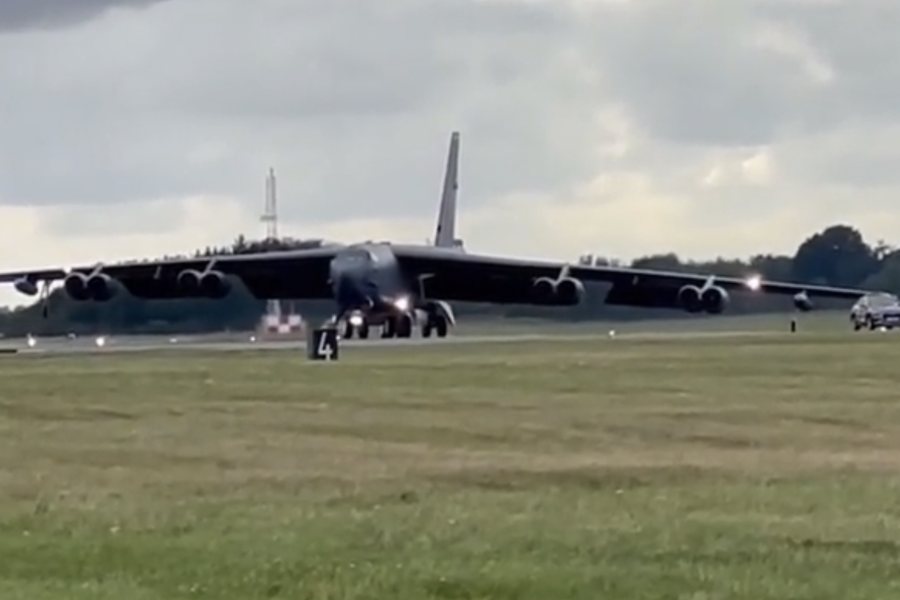The Air Force is investigating an incident involving a B-52H Stratofortress that took place at RAF Fairford, United Kingdom, during the Royal International Air Tattoo on July 16.
Video footage that circulated on social media appears to show the B-52’s wheel-tip landing gear knocking out runway lights as it taxied at Fairford. The public affairs office for the 307th Bomb Wing, to which the B-52 belongs, declined to provide more details, citing the ongoing probe.
“The incident is under investigation at this time,” a spokesperson told Air & Space Forces Magazine. “While the investigation is ongoing we can’t speculate as to what happened.”
Still, many social media commenters were intrigued by the way the bomber appeared to move nearly sideways down the runway. The technique is called ‘crabbing’ and it helps B-52 crews negotiate narrow taxiways.
Unlike many other planes, the B-52 has wingtip landing gear near the ends of its 185-foot wingspan. Those wheels keep the wings, which can flex down 10 or 12 feet depending on how much gas is stored in the wing fuel tanks, from dragging on the ground. The wingtip landing gear is particularly helpful while taxiing and during takeoff, but it can create problems when the runway is too narrow for both wingtip wheels to set down.
“Other aircraft, their wings can hang out over the grass no problem,” Dave Prakash, a former B-52 pilot, told Air & Space Forces Magazine. “But we have tip gear that need runway to touch down on.”
To solve this and other problems, the B-52’s landing gear was designed to rotate up to 20 degrees to the right or left, which helps the large jet land in a crosswind. The swivel wheels can also help the jet move sideways down a narrow runway. In those circumstances, B-52 crews can also move gas from one wing to another, so that the loaded wing’s landing gear is on the ground while the unloaded wing gear is hanging in the air.
“You’re changing the width of the aircraft when you make it tilt to one side and crab to one side,” Prakash said. “Now you’ve reduced your necessary runway [width] by half, because the one wing is now 10 feet in the air so it can hang out over the grass.”
Unfortunately in the video, the loaded wing’s landing gear appears to have still made contact with some of the lights, which can happen now and then, said Prakash—who flew the B-52 at RIAT in 2009, though he did not recall having to crab there. Pilots typically know the runway dimensions in advance so that they can plan accordingly, he said. Often, a crew member gets out and guides the aircraft down the runway to make sure there are no collisions with the lights.
While crabbing is a big help for fitting down narrow runways, it is also essential for B-52s landing at airfields afflicted by crosswinds. Normally, when pilots of other aircraft are about to land on a runway with crosswind, Prakash explained, they fly into the wind until the last moment, at which point they dip a wing down a bit and apply rudder so that they can land with their wheels and nose pointed straight down the runway.
The B-52 can’t play that game due to its large and very flexible wingspan. Dipping those wings at the wrong moment could scrape a wingtip or, at worst, cause a catastrophic cartwheel, Prakash said. So instead of using the rudder and a wing dip to straighten out at the last moment, the B-52’s swivel wheels allow the pilot to keep the aircraft crabbing into the wind while the gear itself points straight down the runway.
“In the B-52, you can be in such a crab angle that the pilot is looking out one of the side windows, because the side window is what’s lined up with the direction of the runway,” Prakash said. “It makes it easier to land because now you don’t have to worry about finessing your rudder or anything like that.”
Instead, B-52s can maintain their crab position all the way down the runway, then stop and reset the wheels to straight-ahead. After that, it’s just a matter of avoiding the runways lights.
